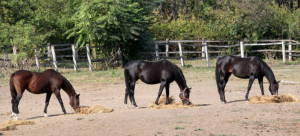 Knowing how to avoid botulism in horses will help you manage your pasture much more easily while reducing risks to your horses. One of the deadliest toxins that horses may encounter is made by Clostridium botulinum bacteria. Some strains of these bacteria live in the soil, while others are found in bird droppings and animal carcasses. Inactive spores can live indefinitely until conditions are favorable for them to become active. These conditions include some moisture and an anaerobic situation (minimal oxygen).
Knowing how to avoid botulism in horses will help you manage your pasture much more easily while reducing risks to your horses. One of the deadliest toxins that horses may encounter is made by Clostridium botulinum bacteria. Some strains of these bacteria live in the soil, while others are found in bird droppings and animal carcasses. Inactive spores can live indefinitely until conditions are favorable for them to become active. These conditions include some moisture and an anaerobic situation (minimal oxygen).
Botulinum toxin disturbs nerve function by disrupting signals that control muscle contraction. Mildly affected horses may show signs such as drooping lips, lowered head carriage, and difficulty swallowing. As more nerves are disrupted, horses can develop body-wide muscle tremors, inability to stand, and labored breathing. Botulism can progress very rapidly, killing horses within the course of a day or two.
Horse owners can take several management steps to lower the risk of botulism for their equines:
- A vaccine is available to protect horses against type B botulism toxin, though it is not effective against other strains. Type B is responsible for most equine cases of botulism, especially in regions east of the Mississippi River. This vaccine can be given to any horse, but is most often administered to foals and pregnant mares. A veterinarian can guide owners in deciding if the vaccination is advisable for their mature horses.
- C. botulinum bacteria produce their dangerous toxin only under anaerobic conditions such as those found inside damp hay bales, especially large round bales. Keeping hay off the ground, feeding only dry hay, discarding any damp or moldy hay, and avoiding the use of round bales are ways to decrease the risk for horses.
- Bacterial spores can also activate in damp grass clippings from mowed lawns. Don’t feed clippings to horses, and don’t discard them where horses can reach them. Piles of rotting vegetation washed into pastures by flooded creeks or rivers are also dangerous and should be removed before horses are allowed to graze.
- Haylage and silage are sometimes fed to horses, though they are more often used as cattle feeds. These products are produced in anaerobic conditions; botulism is known to grow in similar conditions. Special caution should be considered when selecting these products for horses.
- Botulism can develop in deep wounds contaminated by bacteria-laden soil. Check horses daily for injuries, clean all cuts and scrapes, and have a veterinarian examine and treat any significant or deeply penetrating wounds.
If botulism is detected in an early stage, horses can often be treated successfully. Administered soon after signs are noticed, an antitoxin can prevent damage to nerves that are not yet affected. Horses that are able to stand have a good chance of full recovery, though this may require intensive care for several weeks.
Botulism isn’t contagious between horses, but if one horse in a herd is affected, the others should be considered at risk if they have grazed the same pasture or been fed the same hay or forage product. These horses should be removed from the pasture and not given suspect hay. Prophylactic treatment is usually indicated even if no signs are seen.
Interested in learning more about managing your pastures and reducing risk of botulism in horses? Visit or call J & J Hay Farms for more information!
Article brought to you by Kentucky Equine Research.
